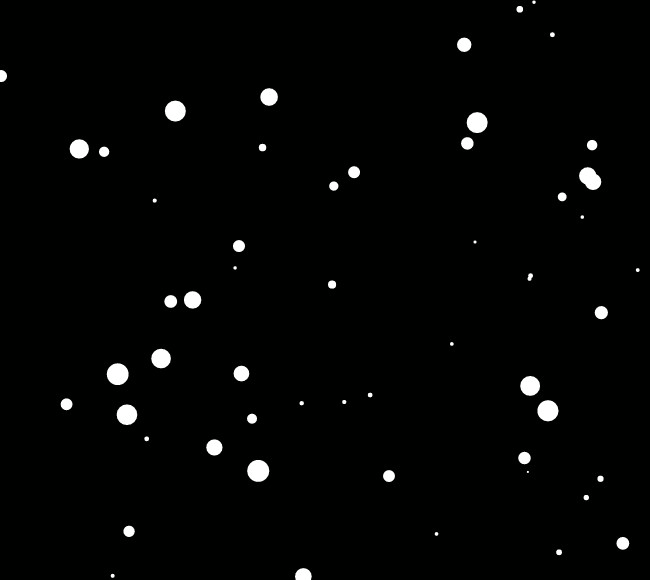How to use HTML5 canvas to make snowflakes fall
This article mainly introduces in detail the HTML5 canvas to achieve the special effect of falling snowflakes. The effect achieves a fascinating and realistic animation effect. Interested friends can refer to it.
I have seen many displays of HTML5 on the Internet. The effect of flying snowflakes is indeed very fascinating. I believe that everyone is as excited as me when watching it. They are also curious and want to study how to implement the code. Although these source codes can be downloaded from many places, I don’t know anyone else has made this. Analysis of ideas and difficulties in animation-like animation.
I just happened to study a little these days, and I took advantage of the time to dissect the needs step by step from demand analysis, knowledge points, and programming. If I try to make a fool of myself in front of you, please don’t laugh. .
The final rendering is as follows:

Figure 1
1. Requirements analysis
1. Circular snowflakes
In this example, the shape of the snowflakes is circular
2. The number of snowflakes is fixed
Carefully observe the number of white snowflakes according to Figure 1. During the falling process, The number of snowflakes in the picture should be fixed. This requirement needs to be obtained through our observation and analysis. This is consistent with the scene we see in real life where snowflakes are flying all over the sky.
3. The size of snowflakes is inconsistent
Each snowflake has a different size, which means that the radius of the snowflake is random. This is consistent with the scene where we see snowflakes flying all over the sky in real life.
4. The position of the snowflakes is moving
Snowflakes fall, and naturally their positions are also moving.
2. Knowledge points
1. Use Html5 Canvas JavaScript to draw a circle - forming a circular snowflake
In Html5, you need to use Canvas at the same time Use JavaScript to draw a circle to form a circular snowflake—arc(x,y,r,start,stop);
2. Random numbers—generate circular snowflakes with different radii and coordinates
In this example, when the web page is loaded for the first time, a certain number of snowflakes with different radii and positions need to be generated, so the radius and coordinates are random numbers; during the falling process of the snowflakes, the radius remains unchanged and the coordinates change within a certain range. Therefore, the coordinates are also random numbers at this time - Math.random()
3. Programming
1. Preparation work
Put a canvas and set the background color of the entire body to black
HTML code:
<canvas id="mycanvas">
您的浏览器不支持canvas画布
</canvas>CSS code:
* {
margin: 0;
padding: 0;
}
#mycanvas {
background: black;
}The effect is as follows: 
Note: canvas has an initialized height and width by default, so you don’t have to worry about it
2. The canvas displays full screen
The JavaScript code is as follows:
//获取mycanvas画布
var can = document.getElementById("mycanvas");
var ctx = can.getContext("2d");
//画布宽度
var wid = window.innerWidth;
//画布高度
var hei = window.innerHeight;
can.width=wid;
can.height=hei;The effect is as follows:

3. Initialization generates a fixed number of snowflakes
According to our above demand analysis and interpretation of knowledge points, first of all, the number of snowflakes is fixed, so we need to define a variable var snow = 100; here it is assumed that the number of snowflakes is 100,;
Generate When it comes to snowflakes, the radius and position of each snowflake are different. We regard each snowflake as an object, then the properties of this object include: radius, coordinates (X, Y), then a snowflake object can be written as var snowOject={x :1,y:10,r:5}, here represents a circular snowflake with coordinates (1,10) and radius 5; in this example, since the radius and coordinates are random numbers, Math.random() is used Generate radius and coordinates (X, Y) for 100 snowflakes respectively;
We have 100 snowflakes here, so in order to facilitate subsequent operations, we use an array to save these 100 snowflake objects.
The JavaScript code is as follows:
//雪花数目
var snow = 100;
//雪花坐标、半径
var arr = []; //保存各圆坐标及半径
for (var i = 0; i < snow; i++) {
arr.push({
x: Math.random() * wid,
y: Math.random() * hei,
r: Math.random() * 10 + 1
})
}4. Drawing snowflakes
Above we have generated 100 snowflake radius and coordinates (X, Y), The following is a cycle of using canvas to draw snowflakes (here, drawing a circle). A function is defined here
The JavaScript code is as follows:
//画雪花
function DrawSnow() {
ctx.fillStyle="white";
ctx.beginPath();
for (var i = 0; i < snow; i++) {
var p = arr[i];
ctx.moveTo(p.x,p.y);
ctx.arc(p.x,p.y,p.r,0,2*Math.PI,false);
}
ctx.fill();
ctx.closePath();Then call the DrawSnow() function, the effect is as follows:

You can try to refresh the webpage multiple times to see if snowflakes of different sizes and positions will be generated (normally, it is possible). If you do this, you will be close to the final effect
Note: Since 100 circles need to be drawn here, the drawing start coordinates are redefined every time a circle is drawn: ctx.moveTo(p.x,p.y); otherwise strange effects will occur. If you don’t believe it, you can try it
5. Snowflakes fluttering
We have drawn 100 snowflakes above. Unfortunately, we can only see the changing effect by refreshing the web page, but what we need to achieve is that the snowflakes do not The moving position of the stop.
First we need to use the setInterval function to continuously redraw the snowflakes. The interval here is 50 milliseconds: setInterval(DrawSnow,50);
同时每一朵雪花的坐标(X、Y)需要不停的改变(在一定幅度内),我们这里的雪花是从左上方飘落到右下方,所以每朵X、Y坐标值都在不停的增大,那我们用一个函数SnowFall()定义雪花飘过规则
该函数代码如下:
//雪花飘落
function SnowFall() {
for (var i = 0; i < snow; i++) {
var p = arr[i];
p.y += Math.random() * 2 + 1;
if (p.y > hei) {
p.y = 0;
}
p.x += Math.random() * 2 + 1;
if (p.x > wid) {
p.x = 0;
<span style="white-space:pre"> </span>}
}
}然后将该函数放入DrawSnow()执行,注意:我们每隔50毫毛重画雪花,必须擦除画布,所以DrawSnow()函数体内必须在前面执行clearRect()函数,即:ctx.clearRect(0, 0, wid, hei);
此时DrawSnow函数定义如下:
//画雪花
function DrawSnow() {
ctx.clearRect(0, 0, wid, hei);
ctx.fillStyle = "white";
ctx.beginPath();
for (var i = 0; i < snow; i++) {
var p = arr[i];
ctx.moveTo(p.x, p.y);
ctx.arc(p.x, p.y, p.r, 0, 2 * Math.PI, false);
}
ctx.fill();
SnowFall();
ctx.closePath();
}最后执行setInterval(DrawSnow, 50);
OK,经过我们上述步骤,小伙伴们是否已经对整个过程及技术实现很清晰了。
完整代码如下(大家可以直接复制到自己项目中执行,测试下效果):
<!DOCTYPE html>
<html>
<head>
<meta charset="utf-8" />
<title></title>
<script src="js/jquery-1.8.3.min.js"></script>
<style type="text/css">
* {
margin: 0;
padding: 0;
}
#mycanvas {
background: black;
}
</style>
</head>
<body>
<canvas id="mycanvas">
您的浏览器不支持canvas画布
</canvas>
<script>
//获取mycanvas画布
var can = document.getElementById("mycanvas");
var ctx = can.getContext("2d");
//画布宽度
var wid = window.innerWidth;
//画布高度
var hei = window.innerHeight;
can.width = wid;
can.height = hei;
//雪花数目
var snow = 100;
//雪花坐标、半径
var arr = []; //保存各圆坐标及半径
for (var i = 0; i < snow; i++) {
arr.push({
x: Math.random() * wid,
y: Math.random() * hei,
r: Math.random() * 10 + 1
})
}
//画雪花
function DrawSnow() {
ctx.clearRect(0, 0, wid, hei);
ctx.fillStyle = "white";
ctx.beginPath();
for (var i = 0; i < snow; i++) {
var p = arr[i];
ctx.moveTo(p.x, p.y);
ctx.arc(p.x, p.y, p.r, 0, 2 * Math.PI, false);
}
ctx.fill();
SnowFall();
ctx.closePath();
}
//雪花飘落
function SnowFall() {
for (var i = 0; i < snow; i++) {
var p = arr[i];
p.y += Math.random() * 2 + 1;
if (p.y > hei) {
p.y = 0;
}
p.x += Math.random() * 2 + 1;
if (p.x > wid) {
p.x = 0;
}
}
}
setInterval(DrawSnow, 50);
</script>
</body>
</html>好了,今天分享就到这里,希望对大家的学习有所帮助。
以上就是本文的全部内容,希望对大家的学习有所帮助,更多相关内容请关注PHP中文网!
相关推荐:
The above is the detailed content of How to use HTML5 canvas to make snowflakes fall. For more information, please follow other related articles on the PHP Chinese website!

Hot AI Tools

Undresser.AI Undress
AI-powered app for creating realistic nude photos

AI Clothes Remover
Online AI tool for removing clothes from photos.

Undress AI Tool
Undress images for free

Clothoff.io
AI clothes remover

Video Face Swap
Swap faces in any video effortlessly with our completely free AI face swap tool!

Hot Article

Hot Tools

Notepad++7.3.1
Easy-to-use and free code editor

SublimeText3 Chinese version
Chinese version, very easy to use

Zend Studio 13.0.1
Powerful PHP integrated development environment

Dreamweaver CS6
Visual web development tools

SublimeText3 Mac version
God-level code editing software (SublimeText3)

Hot Topics
 1390
1390
 52
52
 Table Border in HTML
Sep 04, 2024 pm 04:49 PM
Table Border in HTML
Sep 04, 2024 pm 04:49 PM
Guide to Table Border in HTML. Here we discuss multiple ways for defining table-border with examples of the Table Border in HTML.
 Nested Table in HTML
Sep 04, 2024 pm 04:49 PM
Nested Table in HTML
Sep 04, 2024 pm 04:49 PM
This is a guide to Nested Table in HTML. Here we discuss how to create a table within the table along with the respective examples.
 HTML margin-left
Sep 04, 2024 pm 04:48 PM
HTML margin-left
Sep 04, 2024 pm 04:48 PM
Guide to HTML margin-left. Here we discuss a brief overview on HTML margin-left and its Examples along with its Code Implementation.
 HTML Table Layout
Sep 04, 2024 pm 04:54 PM
HTML Table Layout
Sep 04, 2024 pm 04:54 PM
Guide to HTML Table Layout. Here we discuss the Values of HTML Table Layout along with the examples and outputs n detail.
 HTML Input Placeholder
Sep 04, 2024 pm 04:54 PM
HTML Input Placeholder
Sep 04, 2024 pm 04:54 PM
Guide to HTML Input Placeholder. Here we discuss the Examples of HTML Input Placeholder along with the codes and outputs.
 Moving Text in HTML
Sep 04, 2024 pm 04:45 PM
Moving Text in HTML
Sep 04, 2024 pm 04:45 PM
Guide to Moving Text in HTML. Here we discuss an introduction, how marquee tag work with syntax and examples to implement.
 HTML Ordered List
Sep 04, 2024 pm 04:43 PM
HTML Ordered List
Sep 04, 2024 pm 04:43 PM
Guide to the HTML Ordered List. Here we also discuss introduction of HTML Ordered list and types along with their example respectively
 HTML onclick Button
Sep 04, 2024 pm 04:49 PM
HTML onclick Button
Sep 04, 2024 pm 04:49 PM
Guide to HTML onclick Button. Here we discuss their introduction, working, examples and onclick Event in various events respectively.




